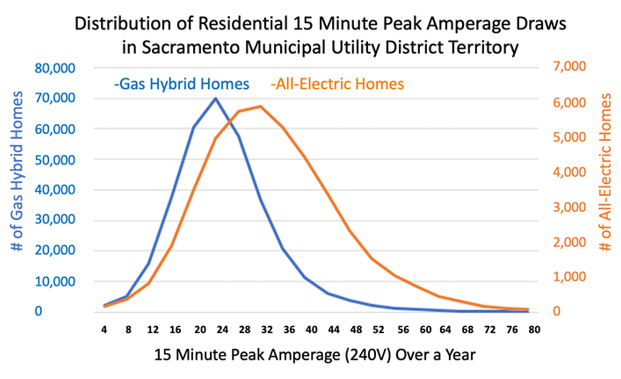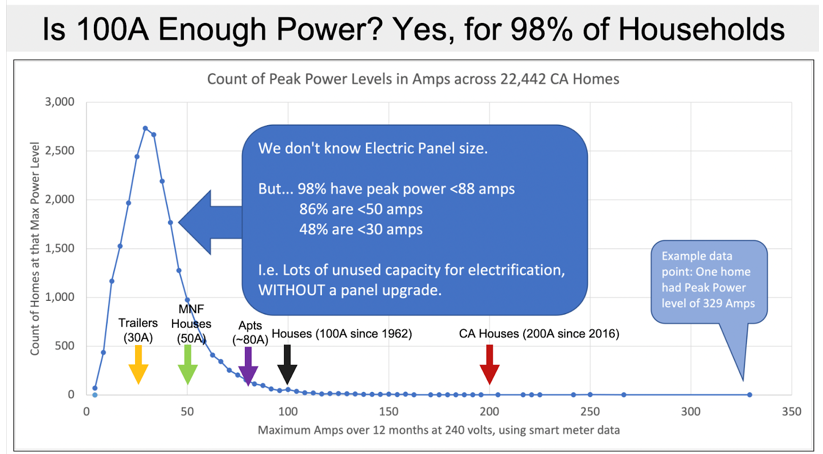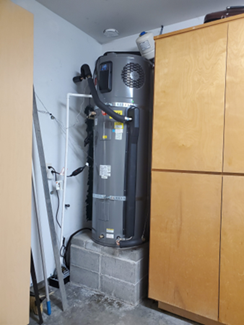Electrifying and decarbonizing existing buildings is critical to address the climate emergency and is one of the key priorities of leading cities, states, and utilities. Many people assume that to electrify an existing home, an electric panel upgrade from 100 amps to 200 amps is required. Yet contrary to that popular belief, 100- or 150-amp panels are enough for most homes to go all-electric. A panel upgrade is costly to the homeowner. The process usually costs $3,000 to $25,000 and takes 2 to 18 months, according to our research and the TECH Clean California Database. Furthermore, if millions of homes upgrade their panels over the next decade, and fill the circuits with appliances that use electricity, utilities could face serious challenges meeting increased demand without making costly upgrades to the grid.
There is a cheaper and easier way to electrify our homes of the future: keep 100-150 amp panels in place and help homeowners go on a “watt diet”. Going on a watt diet means intentionally selecting energy-efficient, correctly sized, low power equipment, and allocating available power to that equipment just when needed. It can include controls that allow devices to take turns or wait until there is enough available amperage to resume re-charging. For example, new retrofit-ready 120-volt heat pump water heaters (HPWHs) are game-changing in that they are rated at just 15 amps (and actually pull only 4-6 amps). They can be placed on a shared circuit, compared to conventional water heaters, which require 240-volts of power and are rated at 30 amps. Learn more with the Plug-In heat Pump Water Heater Field Study Findings & Market Commercialization Recommendations. HPWHs can also store energy when it’s cheaper and plentiful on the grid, acting like thermal batteries, making them grid flexible assets.
As product manufacturers rise to the challenge and develop more energy efficient, grid-enabled heating, cooling, clothes drying, and cooking equipment, the market needs to pivot. Programs and incentives are needed to accelerate a transition toward power-efficient, correctly sized, grid-enabled systems. This approach would allow utilities to keep up with growing communities without needing to make huge investments in upsizing neighborhood grid infrastructure.
Why electric panel capacity matters
Electric panels are a home’s electricity hub, bringing power from the grid and distributing it throughout the house. Back in 1962 the “Live Better Electrically” movement succeeded in changing the National Electric Code, requiring all new houses to be built with 100 amps of power at 240 volts, up from 60 amps. It was enough power then, and it’s enough power now. A study of Sacramento, California homes compared their one-hour peak power demands over one year and showed that the average all-electric home peaked at just 12 amps more than gas-burning homes—up from roughly 20 amps to 32 amps, but far less than the 100 amp limit of most home utility services.

A similar study of 22,442 California homes in PG&E territory showed only 2% of the households peaked above 88 amps—assuming they were all gas hybrid homes, adding 12 amps more peak power.

Smaller capacity electric panels and amperage services could support a mixed-fuel home, or a home with both electric and fossil fuel fired appliances. That will not be the case as more people install all-electric systems for heating, cooling, domestic hot water heating, and cooking, and want to charge their electric vehicles with renewable energy to reduce carbon emissions. Enabling full-home electrification can require a $3000-$25,000 upgrade to electrical service depending on the location and necessary upgrade. This is a big shift for homeowners, who don’t want to run out of power to take hot showers, dry their laundry, or charge their electric vehicle (EV). The more electric loads in a home, the larger its electric panel must be. So, it’s understandable that most homeowners who want to electrify their homes automatically assume they must upgrade their panel to accommodate their increased appetite for electricity. But thanks to rapid innovation taking place in the water heating, space heating, and cooking industries, that’s no longer the case.
Today, it’s becoming easier to find low-power, plug-in technologies such as 120-volt heat pump water heaters (HPWHs), Rheem has two plug-in HPWH models available and other manufacturers are developing their own. The Advanced Water Heating Initiative has played a significant role in accelerating innovation in this space. Similarly, there are multiple HVAC manufacturers that have market ready 120-volt air source heat pumps i.e. mini split heat pumps or air source heat pumps that can help with zonal conditioning of the space. These plug-in heat pumps are a great option for DIY installs. Induction stoves are also making news. A featuring an integrated 4-kWh battery is another technological innovation hitting the market, allowing homeowners to electrify without expensive electrical work.
In addition to low-power equipment, there are power balancing devices such as smart splitters that will help charge your electric vehicle and another electrical device simultaneously, but with controls that will allow prioritizing consumer preferences or balancing the charging logic.
Start by creating an electrification plan
Creating an electrification plan can help a homeowner determine the most cost-effective and climate-focused path forward. As energy efficient technologies that use less power become more widely available, utilities and governments could incentivize homeowners to create an electrification plan.
An electrification plan allows homeowners to sequence their upgrades, choose the best products and power-efficient systems that will free up extra panel amperage. The extra amperage can then be used to charge EVs for a longer period of time, or charge them in tandem with other appliances. Did you know that a 50-amp EV charger circuit can charge 109,000 miles per year at 8 hours per day? That’s overkill for people with 12,000 mile per year usage on a 20-amp circuit that could provide 39,000 miles per year.
Some homeowners, especially those with 60-amp panels, will inevitably need to increase the capacity of their electric panels to facilitate EV charging. But thanks to the Inflation Reduction Act, there are incentives available that reduce the upgrade cost.
Watt dieting has the potential to reduce costs and construction delays for the homeowner, eliminate costly grid upgrades for the utility, and free up grid space for new homes. The home of the future can use the panel of the past if we choose power-efficient appliances.
Authors:
Amruta Khanolkar, Associate Director, New Buildings Institute
Sean Armstrong, Managing Principal, Redwood Energy
Tom Kabat, Volunteer, Fossil Free Buildings of Silicon Valley
